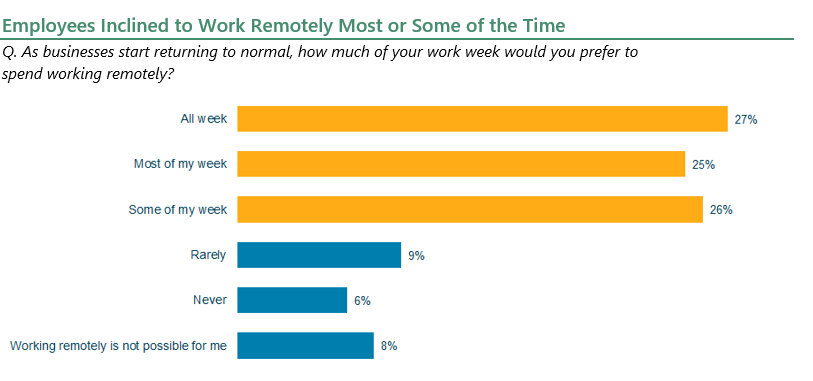
The COVID-19 outbreak and the massive shift to remote work placed a spotlight on real-time collaboration – and video conferencing, in particular – in the early days of the pandemic. However, with some regions looking to relax lockdown conditions, the conversation is now shifting to the hybrid work model, combining remote and in-office work. This transition is expanding business communications and collaboration beyond real-time voice and video to encompass asynchronous virtual interactions.
Let’s look at key data points from the 451 Alliance Workforce Productivity & Collaboration, Work Execution Goals & Challenges 2021 survey showing how this transition is influencing market requirements for business communications and collaboration.
What the data says
According to our data, supporting remote collaboration over an extended period of time – as opposed to occasional remote working by some employees – entails numerous cultural, operational and technical challenges. Fielded in April 2021, survey results show that, as the lockdown period was extended from a few months to more than a year, organizations uncovered challenges that cannot be addressed with real-time collaboration alone, including ‘meeting fatigue’ and avoiding distractions.
451 Alliance data shows that the top challenges cited by employees working remotely include ‘focusing on their work and not being distracted’ (26%) and being ‘on the same page’ as their colleagues (23%).

Survey data also indicates that collaboration requirements are likely to increase in the near term. When asked about the amount of time spent collaborating with colleagues from other business divisions, 51% of responding employees said that they expect it will slightly (30%) or significantly (21%) increase over the next two years.

Survey results also show that, even as some regions begin easing lockdown conditions, flexible work arrangements will likely become permanent for a substantial number of employees and organizations. This was already an emerging trend prior to the outbreak: Survey data shows that 50% of survey respondents were working from home at least a few days a week prior to COVID-19.

Survey data shows that a substantial number of employees (78%) are inclined to work remotely at least some of the time as businesses start returning to normal. These findings are consistent with other 451 Research surveys. For instance, data from our Digital Pulse, Business Reinvention & Transformation 2021 survey shows that, among those organizations reporting a significant transformation stemming from the COVID-19 outbreak, most expect to be fundamentally different going forward – including an increased reliance on remote work (75%).

Furthermore, data from our Workforce Productivity & Collaboration, Employee Lifecycle & HR 2021 survey indicates a continued preference for investment in remote work and flexible-hours initiatives with HR professionals. Fielded in March 2021, survey data shows that 48% of HR respondents are thinking more deeply about flexible work arrangements in light of the events of 2020 and the impact of COVID-19; an additional 43% say they have a stronger focus on supporting remote work. On the employee side, when asked what workplace changes in the past year had the most positive impact, 45% of survey respondents cited the ability to work remotely.
Want insights on workforce productivity and collaboration trends delivered to your inbox? Join the 451 Alliance.

